|
Le
Claire Iowa
River
Men

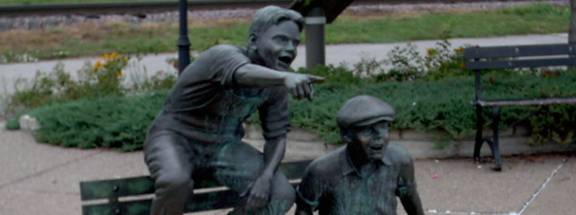
Watching for the Ferry
By
John Bloom
Compiled by Georgeann McClure
This
is not a complete list
(If
you have any information on river men please add it. )
Capt Alvah O. Day
ALVA O. DAY,
FORMER
RIVER
STEAMBOAT CAPTAIN, DIES
Alva O. day,
supervisor of the United States Steamboat Inspection Service in this district
and old-time Mississippi river steamboat captain, died Monday at
Howard
Hospital
, of septic poisoning from a throat infection.
He resided at
3324 South Jefferson Ave.
Capt. Day, who
was 66 years old, had been in river service for more than 40 years and had been
connected with the Government since 1916. Previously
he was captain of steamers for the Diamond Jo Line.
In 1910 he piloted from the North the last large raft of logs sent down
the river.
Capt. Hugh Pollock
Davenport
Democrat
Dec. 5, 1911
Pg. 13
SAD ENDING OF RIVERMAN’S LIFE
Former Rapids Pilot Dies in Abject poverty Across the River
Concerning the
death of Capt Hugh Pollick, (sic) brief mention of which was made in last
evenings Democrat, the Rock Island Argus gives the following details:
Walking along
the levee yesterday morning at 11:30, Fred Gall
and Peter Trenkenchuh approached the
northern track of the Rock Island & Peoria Railway between Nineteenth and
twentieth street
, where they came upon a man lying behind a freight car, all curled up, his head
resting near the rail. A large
bruise was discovered on the left side of the head just above the eye, and
thinking that the man was under the influence of liquor, they took hold of him
to arouse him, Gall at the same time remarking to his companion, “I guess you
had better call the police patrol.” On seizing the supposed sleeper they were
horrified to observe that he was stiff and cold, having been dead for some time.
Pollock James
Engineer
The Daily Times
December 2, 1918
James Pollick Laid To Rest
The funeral of
James V. Pollock, Jr., was held this afternoon at 2 o’clock from the home of
his parents in Le Claire, conducted by Rev. Me. E. Krotzer.
Internment was in Le Claire cemetery.
Deceased was the eldest son of Mr. And Mrs. J. V. Pollock of Le Claire,
at whose home he died Saturday afternoon at 2:30 o’clock after a few days
illness of influenza followed by pneumonia.
He was born in
South Dakota
Oct. 4, 1883, and was a marine engineer by occupation.
On Oct. 4, 1910, he was united in marriage to Miss Bertha Schlpull, who
preceded him in death June 15, 1917.
He is survived
by a little 7 year-old son, Robert, his parents two sisters, Mrs. F. S. Morey of
Le Claire and Mrs. C. H. Suiter of
Davenport
also two brothers, Jno E. Pollock of
Morse
,
Canada
, and Corpi, Jos. Of
Morse
,
Canada
, and Corpi Jos. A. Pollock, now in
France
.
He was a
member of Snow Lodge, A. F. & A. M. also the McChanices Union.
The Weekly Times
June 12, 1908
Pg. 4
Dubuque
To Arrive From South July 2
“Crew of The
Columbia
”
“Captain C. H. Farris of Montrose
Pilot A. F. Hallinshall of
Clinton
Mate Homer Roberts of
Clinton
Clerk F. S. Ratterman of
Warsaw
First Engineer F. E. Goldsmith of
Canton
Second Engineer James Pollock of Le Claire
Steward Charles Efland of
Moline
Chef Arthur Smith of
Davenport
”
Capt. J.W. Rambo
One of Last Raft Pilots Succumbs at Le Claire in his
Eighty-First Year
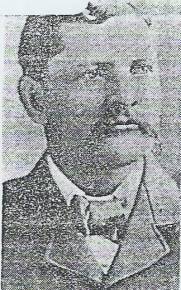 Captain Rambo; LeClaire,
Iowa Captain Rambo; LeClaire,
Iowa
Davenport Democrat
Jan 30, 1925
With the death at 5 o’clock this morning at Le Claire of Capt. J. W.
Rambo, is marked the passing of one of the few remaining raft pilots who
plied the Mississippi river in the heyday of steam boating before the
ramifications of the railroad industry had made obsolescent and almost
obsolete the slower and less direct transportation afforded by the
locomotive.
Capt. Rambo was 81 years of age, and had been retired from active
piloting since Oct 15, 1922. His declining health was not marked until the
last few weeks.
For sixty years he piloted rafts thru the Le Claire rapids, having gained
his first river experience when an adolescent.
The fascination of the river held for him the remainder of his life. He
guided hundreds of boats up and down the Mississippi and earned a reputation
as a rapids pilot in the days when railroading was in its infancy..
During the last years of his active river service, Capt. Rambo was
commanding officer of the steamer “Artimus Gates” of Clinton
owned by the Clinton Sand and Gravel company. He knew well every bend and
shoal in the river for many miles on either side of his home city.
For four terms, he served as mayor of Le Claire, and was acting in that
capacity at the time the present city hall was built there. He also served
as a councilman of Le Claire for several years.
Capt. Rambo was born in Rapids City, Ill., July 27, 1844 across the river
from Le Claire and with his parents came to Le Claire when he was but two
weeks old, retaining his residence there ever since. He married Miss
Josephine Slaughter at Princeton, Nov. 24, 1864, and the couple celebrated
their sixtieth wedding anniversary on Thanksgiving day of last year.
In the Masonic fraternity, Capt. Rambo won distinction by serving in the
various offices of the fraternity, including that of worshipful master. He
was a member of Snow Lodge No. 34 at Le Claire, with which he became
affiliated in 1871. At the time he was initiated, his brother-in-law, Capt.
Joseph Hawthorne, also a pioneer river captain, also took the initiatory
degree, and both were equally prominent in the offices of the lodge. In
1921, the lodge celebrated the golden anniversary of the affiliation of
Capt. Rambo and Capt. Hawthorne.
In childhood, Capt. Rambo attended the old Sycamore school, at that time
resided with his parents near the old water mill.
Those who survive are his wife; one daughter, Mrs. B. J. Metzgar; and one
grandson, Ward Metzgar of Dubuque.
Funeral service will be held Sunday afternoon from the home under the
auspices of the Masonic Lodge. Interment will be in the Le Claire Cemetery.
--from book "Rivermen Muscatine, Iowa" compiled by
Georgeann Mcclure
Rhodes William
Capt.
Davenport
Weekly Gazette;
February 23, 1881
Capt William Rhodes ,
The death of Capt. Wm. Rhodes, one of the best
known steamboatmen on the Mississippi river, occurred at his home in
St. Paul
the 14th inst. This intelligence will prove a painful surprise to his many
friends up and down the river, as there were but one or two persons outside
of his domestic circle who knew he was sick. Capt. Rhodes was born in
Devonshire
,
England
, February 21, 1825, and came to this country in about 1843. He was engaged
in business at
Cincinnati
,
Ohio
, from 1854 to 1858 and went to
Minnesota
in '59. He was connected with the business of Commodore Davidson from that
time until his death. He was an officer of all the steamboat companies that
Commodore Davidson controlled and generally acted as financial manager of
such companies. It is said that the Commodore is largely indebted for his
property to the sound judgment, excellent management, and industrious
methods manifested by Capt. Rhodes in discharging the trusts confided to
him.
Rhodes Stephen
Raftsman
Senthouse
George
E. Servis
Engineer T. J. Robinson
* see St. Clair Roderick
Shannon
Shannon
Stone Glendale Cemetery
le Claire,
Iowa
Photo
Bob Jones

Shannon Family
Stone
Shannon George
Mate/cook
Sept. 19, 1951
Final rites
for George W. Shannon, Sr. were held at 3 p. m. today in Full Gospel
tabernacle, Le Claire
Burial was at
Glendale
Cemetery
, Le Claire
Pallbearers
were Roy Long, Earl Pitzenberger, Ben Youngers, Jim Roberts, Francis Buchiet
and Arthur Newton.
- He
was mate on steamboat on the
Mississippi river
- He
and his wife,
Ada
, worked as cooks on the river together.
Photo
Shannon
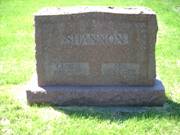
George Shannon
1868-1951
Ada
Shannon
Robert Shannon
The
Davenport
Democrat
Sept 14, 1910
Pg. 2
Robert Shannon
The remains of Robert Shannon who passed away
Saturday in
Rock Island
, was brought to his native town Monday morning and laid to rest in Le
Claire’s beautiful “City of
The Dead
”. The remains were
accompanied by the sons and mother of the deceased and joined here by
brother and sisters and many other relatives.
Rev. Bailey and a choir composed of Mrs. George Tromley, Miss Annie
Laird and Jas Suiter, held services at the grave.
The following assisted with the casket.
L. Morey, M. Ney, August Abraham, Lee Suiter, Ralph Ewing and S. W.
Disney.
Researcher Sue Rekkas
* there
were three Shannons Hugh Shannon, Robert Shannon and James Shannon
Shannon Hugh
Engineer

Hugh Shannon
November 9, 1923
Rock Island
Argus.
Port Byron Globe
Nov. 17, 1923
VETERAN
RIVER
ENGINEER DIES IN
ROCK
ISLAND
Had Worked Continuously on
Mississippi
Since 1886; Death Follows Illness of One Week.
Hugh
Shannon aged 80, veteran riverman on the
Mississippi
, died at 4:20 yesterday afternoon at the home of his daughter, Mrs. H. J.
Dodds,
1029 Seventeenth street
,
Rock Island
. He had been ill for only a
week, having worked until Nov. 1, when he was taken sick with complications,
which caused his death.
Born in
Londonderry
,
Ireland
, July 3, 1843, he came with his parents to
Le Claire
,
Iowa
, when two years old. He lived
there until 1901, when he moved to
Rock Island
.
He was
educated in the Le Claire School, and at the age of 17 was granted a license
to operate a ferry oat between Port Byron and Le Claire.
A few years later he worked as an engineer on the
Milwaukee
railroad. In 1866, at the age of
23, he was issued an engineer’s marine license, and up to the time f his
death he had not missed a season working as a river engineer.
For a period of 25 years Mr. Shannon was employed by the Weyerhaeuser
& Denkmann company., and when that concern discontinued operating raft
boats he began working on river pleasure craft.
Recently he had operated the Kalatan, pleasure boat of Mr. and Mrs.
William Butterworth of
Moline
.
Married in Le Claire
Martha
Alvira Holsapple and Hugh Shannon were married in Le Claire, in August 1867.
Mrs. Shannon died in Le Claire 35 years ago.
Five Children were born to the union, of whom two survive.
They are; Mrs. J. A. Dodds,
Rock Island
, and Mrs. J. A. Mayer, Le Claire, he had three grandchildren.
Short
services will be held Sunday afternoon at 1 o’clock at the Dodds home in
Rock Island
, after which the body will be taken to Le Claire, where the funeral will be
at the Presbyterian Church. Rev W. L. Essex will officiate at the service in
Rock Island
. Interment will be in the Le
Claire Cemetery.
Photo
Shannon
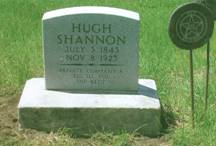
Capt. Hugh
Shannon 1845-1923
Shannon James
Mate
Le Claire
March 25, 1909
Tuesday
morning at 3:30 o’clock at his home here occurred the death of James
Shannon, after an illness of about ten days duration from infirmities of old
age. He was 78 years of age.
He was born and married in county Donegal, Ireland, and came to
America in 1852, locating in Rock Island, Ill., where he owned a large track
of choice timber and coal land which he afterward sold and moved to Le
Claire about thirty years ago. At
the beginning of the Civil war, he enlisted in 152 Illinois Infantry, with
which he taught throughout and received an honorable discharge.
Four daughters and one son survive him as follows:
Mrs. J. C. Swank of
Coal Valley
,
Ill.
, Mrs.
“A Raft Pilots Log’
Page 130
Walter Blair
Walter Blair speaking:
“With our boat repaired, painted and fitted she
passed a fine annual
United States
inspection and on orders from Manager Van Sant I got coal and
provisions aboard and left LeClaire for Beef Slough on the night of
April17, 1882. I had Vetal Burrow, a French-Canadian as my pilot; the
engineers. Shannon and Lancaster, previously mentioned, James Shannon,
mate,
with seven good men on deck. Two men to be watchmen and
nigger runners and two firemen, composed the operating crew.”
Glendale
Cemetery
Le Claire
Photo
Shannon
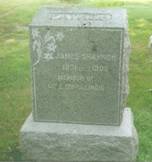
James Shannon
Shannon Lawrence

Bettendorf
Lawrence M. Shannon, 85, of
1611 Golden Valley Drive
, died Wednesday at
St.
Lukes
Hospital
Services
will be 11 a. m. Saturday at McGinnis funeral Home.
Burial will be in
Glendale
Cemetery
,
Le Claire
,
Iowa
Visitation
will be 4-8 p. m. Friday at he funeral home.
He had
been employed on steamboats on the Mississippi river for years had been
a supervisor at Rock Island Millworks many years and was employed at Annie
Wittenmyer Home,
Davenport
, retiring in 1972.
He married
Nina Marsen in 1945 in
Davenport
.
He was a
graduate of
Coyne
Electrical
College
,
Chicago
.
Survivors
include his wife, a daughter, Ruby (Mrs. Lyle) Cook, Le Claire, a son, M.
Lawrence Shannon, Dixie, ala; 11 grandchildren; 20 great-grandchildren; and
sisters, Leatha (Mrs. Roy) Couch, Cincinnati, Ohio; Vivian Craig, Rock
Island; and Gladys Cade, Elgin, Ill.
Photo
Shannon

Lawrence
Shannon
1904-1989
Glendale
Cemetery
Le Claire
Shannon Robert
Globe
Port
Byron
Ill.
Feb. 13, 1913
Obituary
Robert
Shannon, whose death occurred in Le Claire Feb. 6th 1918, was
born in
Londonderry
,
Ireland
, Feb. 5th 1847, making his age at death 66 years and one day.
He came with his parents from the old country to Le Claire in 1853,
and in 1861, at the age of 14 years, he enlisted in Co. F, 52nd
Ill. Vol. Inf., for three years of during the war, and after serving a
little over two years he reenlisted for three years more. Making him a
veteran, and he served until the end of the war.
He participated in the battle of
Shiloh
,
Tenn.
, and the battle of
Corinth
,
Miss.
, and was with Gen’l Sherman in the campaign through
Georgia
, his march to the sea and back through the Carolinas to Washington, D. C.
when he marched in the grand review and was discharged from the service at
Louisville
,
KY.
He was first united in marriage
to Sarah E. Huginun of
Albany
,
ILL.
And by this union two children were born and are now Mrs. Ryan and Mrs.
Frank Shannon of
Benton
,
Iowa
. He was an engineer of the
river for 53 years, and in the year 1871 his wife died leaving him the care
of the two small children. In
the year 1877, he was again united in marriage to Miss Amelia Meyer of Le
Claire, and by this union one child was born a son, Charles who died in
1888, at the age of ten years.
In the
year 1899, he quit the river business and moved to
Oklahoma City
, but the climate did not agree with him so in 1901 he returned to Le Claire
and opened a confectionery store and had established a good business when
death had overtaken him. He
leaves to mourn a wife, a wife, a son and a daughter, before mentioned.
The funeral services were conducted by the Rev. Memmot of Le Claire,
and the Odd fellows had charge of the remains.
The remains were laid to rest in Le Claire Cemetery,
Those
present form out of town were as follows:
Bradford Chandler, a member of his old company, of Clinton, Iowa;
Hugh Shannon, Rock Island; Mrs. Harry Dodds, Rock Island; Jack Byers, Rock
Island; Mrs. Miller and daughter, Camanche; James Shannon, Silvis, Ill.;
Joseph Turner, St. Louis; Mrs. Jack Vogel, Davenport; Mrs. Blanche Zuber,
Davenport, Jack Shannon, Davenport, Mrs. C. La Grange, Pleasant Valley, Mr.
and Mrs. Joseph Schafer and daughter, Port Byron.
J. D. B.
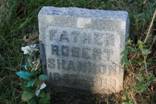
Robert Shannon 1847-1913
Glendale
Cemetery
Le Claire
Shannon
Robert
The
Davenport
Democrat
Sept 14, 1910
Pg. 2
Robert
Shannon
The
remains of Robert Shannon who passed away Saturday in
Rock Island
, was brought to his native town Monday morning and laid to rest in Le
Claire’s beautiful “City of
The Dead
”. The remains were
accompanied by the sons and mother of the deceased and joined here by
brother and sisters and many other relatives.
Rev. Bailey and a choir composed of Mrs. George Tromley, Miss Annie
Laird and Jas Suiter, held services at the grave.
The following assisted with the casket.
L. Morey, M. Ney, August Abraham, Lee Suiter, Ralph Ewing and S. W.
Disney.
Researcher
Sue Rekkas
“A Raft Pilots Log”
Walter Blair
Pg. 130
Walter Blair Speaking:
“As soon as I finished my term of school I secured a
room at the Gault
House in Le Claire and took real pleasure in working on my own boat,
cleaning,
painting , changing a little here and there to enable me to
house, feed and sleep a crew of eighteen men.”
“I was fortunate in securing Robert Shannon as chief
engineer and George O.
Lancaster as a good carpenter and a handy man in many ways in addition
to being a good engineer.”
Photo
Bob Jones
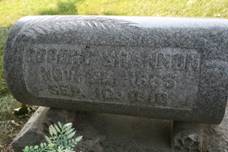
Robert Shannon 1910
Glendale
, Le Claire
*Descendant Larry Shannon and his wife Pauline
Shannon contributed the information on the Shannon Rivermen.
Photo
Shannon
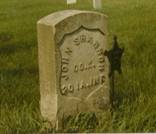
John Shannon
Smiths
Davenport
Democrat and Leader
Dec. 15, 1918
FORMER RIVER PILOT
PASSES AWAY SATURDAY
Captain
Fuller Smith of Steamer
Verne Swain Dies in
Chicago
According
to word received late Saturday, Captain Fuller Smith, former well known
river pilot, and for years captain of the steamer “Verne Swain” passed
away at 8 o’clock Saturday morning at the home of one of his daughters in
Chicago.
The
remains will be brought to Le Claire for burial, and interment will take
place there, announcement of the time to be made later.
Captain
Smith’s old home was in Le Claire, and during the long period that he
spent in navigation the river he resided there, but removed to
Davenport
. He has however, made his home
in
Chicago
for the past ten years.
The
survivors are two daughters Mrs. Grace Tolleson and Mrs. Lola A. Stone, both
of
Chicago
; two sisters, Mrs. Net Holsappple and Mrs. Cynthia Becker, of Le Claire:
also two brothers, Peter of le Claire and George of Moline, Ill.
--Sue Rekkas
The Daily Times
Dec. 17, 1918
Pg. 12
Capt. Smith Funeral Held
The
funeral of Capt. Ira Fuller Smith, who died in
Chicago
, Saturday, was held Monday afternoon at 2 o’clock at Le Claire, Rev. M.
E. Kroster officiated at the service. The
pallbearers were six nephews of the deceased.
They were Orrin Smith, Nelson Smith, Frank Smith, George Holsapple
and Frank Becker. Interment was
in Le Claire cemetery.
--Sue Rekkas
Smith
Fuller
Davenport
Sunday Democrat
June 12, 1898
Clears
up mystery
Pilot Fuller Smith Explains the Low stage of water
George
M. Waters, Moline Correspondent of the Waterways Journal, has the following
interesting bit of pilot house profanity and philosophy charge up to him.
Moline, Ill., May 30, 1898. Do
you Know Fuller Smith? If not,
I will introduce him to you: Mr. Editor, Mr. Smith, pilot on the Verne Swain
for the last nine years, making two trips a day over the rapids.” Now,
there is a sly old fox of a wheel spinner that can juggle a boat and is up
to all the tricks. He knows all
the little pickets, ct offs and openings to put his boat into and through
when the water is low, and in a race he will beat you every time.
He is a lovely talker. You
should hear the ornamental language he uses, especially when the bridge
tender is slow to open the draw.
When a new engineer came on and asked: Mr. Smith, which is your slow
bell? He answered: “H--! Got
no slow bell! What you want a
slow bell for? This boat’s
slow enough without running on slow bells.
When you get signals, twist the wheel out of her; that’s what you
do, Huh! Slow Bells? Nit!”
While coming down yesterday from Hampton on the Swain I was always in
the pilot house, and asked Smith about the stage of water.
“Water? Got no water! Just had wheels put on her bottom!
Can’t you feel her when she runs over the rocks?” “They are
moving freight down below.” “No,
sir; that’s rocks-hard rocks. As
long as they allow street sprinklers and sich to pump the water all out of
the river and spread it over the ground, just so long we’ll have low
water, Gad! I drove a nigger off up at Le Claire the other day that had his
mule down to water, and the next morning he came down to the land and says:
“Please Mr. Captain, can let my mule drink out of your river?”
The
Davenport
Democrat and Leader
June 10, 1928
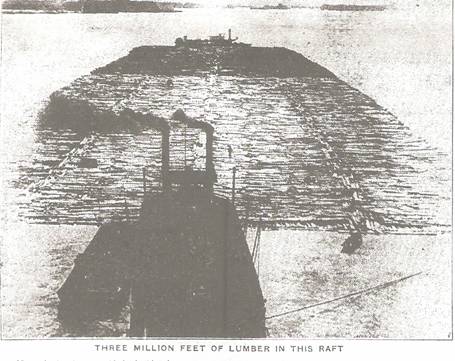
CAPTAIN ORRIN SMITH, Le Claire, ran largest rafts
down rapids: Father furnished Evidence for
Lincoln
On a fair
day in May 1856, the sidewheel excursion steamer Effie Afton, puffing down
the
Mississippi
, struck a pier of the first bridge across the river between
Davenport
and
Rock Island
.
The impact
of the collision or some other force, upset a stove on the steamer’s deck
and the big boat went up in flames. The
bridge property of the
Chicago
,
rock Island
and pacific railway, being a wooden structure was also partially destroyed.
Out of
this incident grew the famous
rock Island
bridge case in which Abraham Lincoln distinguished himself, winning the case
for the railroad when the steamship company brought suit.
What is
more important the resulting decision set a precedent which struck the
opposition in the building of trans-Mississippi bridges a death blow.
Probably
no one at this day remembers the incident more distinctly than captain Orrin
Smith of Le Claire, for 48 years a river pilot in all capacities and today
actively engaged in guiding the Lone Star on almost daily trips between
Princeton and
Davenport
.
Father
Furnished Evidence
“My father, Captain John E. Smith furnished evidence
in that case for the railroad company,” he recalled the other night.
Tilted back in an old chair on the lower deck of the Lone Star he
rehearsed the incident while a kerosene lamp with yellow light shown thru
the smoke from a cigar he puffed occasionally.
“It
nearly made a farmer out of my father after years on the river.
Lincoln
and the
rock Island
wanted to prove that the bridge was not an obstruction to river traffic and
hired my father to pilot a boat up and down the river for an entire day.”
He did it
successfully, easily. Probably
made a dozen trips or so in the same channel where the Effie Afton had gone
down. “That made the river men
mad and they wouldn’t give dad a square deal so he went back to Le Claire
and moved into a small farm. In
30 days steamboat owners were after him.
“Come on
back and pilot our boats for us” they begged him, “They’re going to
pieces in the rapids.”
“I’ll come on back for $10 a day, work or play,”
was his reply and they agreed to his terms.
Compensation Unknown
Records
show that
Lincoln
received $500 for winning the case, but what Captain John Smith received,
more than his daily wages, Captain Orrin Smith does not know.
“Like
father, like son” the present Captain Smith has proved himself the equal
of his father in his mastery of the rapids, which have been the downfall of
many a river pilot and stout steamboat.
In his half century of river navigation he has never lost a boat on
water that churn over treacherous stones.
He made a name for himself when huge lumberrafts were run down the
river from
Minnesota
and
Wisconsin
forests and ahs the distinction of bringing down the two largest rafts ever
floated across the rapids.
Fifteen
hundred feet in length was one of these monsters, in reality a raft and a
half. Captain Smith explained
and conceived when a river captain was roused to new efforts by a story in a
Davenport
newspaper telling of the “greatest raft in history.” Brought down the
river by a rival.
The second
raft, not quite so long, but a double decker and containing 2,600,000 feet
of lumber is shown in the accompanying photograph.
Two Boats required
To move
these tremendous bulk of logs down the river, two boats were required, one
at the stern and another at the head of the raft, the “after called a
“bowboat” the bowboat made
it possible the swinging of the raft back and forth across the stream.
Incidentally
it was captain John smith again who conceived the idea of the bowboat and
his son who carried this idea to the ultimate perfection.
“Huge
rafts power the essential downfall of river men.”
Captain Smith declares, “With smaller rafts logs would have been
moved less rapidly and the supply would have lasted longer.
As it was the last raft was floated down the
Mississippi
many years ago and a lot of pilots were thrown out of work.”
“I’ve
run all kinds of boats.” He
recalls. “Raft boats
freighters, excursion steamers, and sand barge boats.
There used to be a boat each way daily between
St. Paul
and
Davenport
, crowded too with people sleeping on deck cots or wherever they could find
a place.
Will Never Come Back
“Now
they’re all gone, burned, sunk, rotted, except for a few small ones which
as were running here. They’ll
never come back. They don’t
pay, the railroads put them on the run and now the automobile has the
railroad going. Once owned a
boat myself, paid $15,000 for her and was lucky to get
$1,800 when I sold her.” He
explained. Consequently in the
attempt to return large traffic, Captain Smith sees but madness where, he
says, the cost will far exceed any return and where ice locks the channel
for five months out of 12 months.
But as
long as any kind of a boat courses up and down the river here Captain Smith
will live the life he knows best. He
has been on the water from the time he was able o row his first skiff.
“I used to swim like a fish, tho I haven’t been in the water for
years.” He says.
Why I used to swim across the river from Le Claire to Port Byron any
time the notion struck me, and back again,
“Many’s the time I’ve given passengers on those daily boats a
good scare. Just as they pulled
away from Le Claire bound for Pt. Byron, I’d paddle up behind in my canoe,
throw a rope over the rudder beam and ride into mid-river.
Then I’d upset my canoe and come up under it, making a big shout as
I went down.
Under the Boat
“People
would see the canoe turned over and wouldn’t see me come up.
I’d be under the canoe where there was plenty of air and there
I’d stay until I thought a boat would be coming after me, then up I’d
pop. What a laugh and stare that
would give them.” He roared.
“Used to be a crack shot too.”
He reminisced. “Where
other fellows used a shot gun I’d use a rifle or pistol.
Always used to hunt rabbits with a revolver and get them too.
If I saw them before they ran.
“One day
we were coming down the river and saw a big flock of swans way ahead.
I called to my engineer, Frank Long.
He got his shot gun and I my rifle.
When we were about 50 yards away, close enough for the shot gun, I
banged away twice and to swans fell, frank called up and asked “did you
see those two I got” “Well
until you see the balled marks I answered and sure enough I’d hit them and
he missed ‘em. “One other
time Jake Brasser, a boxer, wrestler, and a crack shot, as he
claimed, boasted he could out shot me. Fellows
always used to be shooting and then hanging the targets up in a saloon.
A Crack Shot
“Well we
put up a six inch target at 35 yards. Jake
had a five shot and O a seven shot revolver.
We fired and then investigated the results.
I’d placed all seven shots in the six inch circle, piecing the
bull’s eye with all of them. Jake had hit t only once, but that was right
in the center of the bullseye. Say,
he put that target up in the saloon, and didn’t get over it for days.
We used to laugh about that.
Returning
once more to the talk of swimming he warned “Don’t ever get into ice
water, it’ll paralyze you. He
told the incident of his own initiation, his first and last experience which
happened about 30 years ago.
“We were
coming back from hunting near
Princeton
. Had our boat full of guns,
camping stuff and straw in the bottom. A
stiff wind was whipping the waves into whitecaps and water stopped into the
boat. All at once she started
head first for the bottom.
Into the icy water
“The
fellow with me grabbed his gun and went down but I grabbed an oar in one
hand the boat with the other. Down
I went too, and then managed to get a hold of George.
Under water I turned the boat upside down, out fell the stuff and up
came the boat, bottom side up. “Hang
on the boat I called as I pulled George up, and holler like the devil.
“ I managed to climb on top the boat , straddle it and began to
paddle. Finally a fellow heard
us shouting and paddled out. He
pulled George into the boat and I sprawled in paralyzed from the hips down
where the icy water had soaked me. When
I got to shore I ran all the way to a saloon, got three hot whiskeys, went
home, put on dry clothes and came out all right.
We both did, but stay out of ice water.”
With that
Captain Smith fell back to dreaming a minute.
“Well
guess it’s about time to look for the hay, he spoke suddenly,” and rose
to turn down the lamp.
Researcher Sue Rekkas
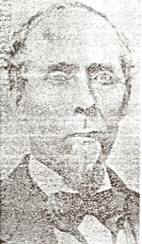
John Smith
Smith steamboatmen from Le Claire
1870 Le Claire Federal Census
Smith Peter M. 40 M W Runs Ferry Boat Pa
Smith John E. 36 M W Boat Pilot . . Pa .
Smith Oren 11 M W . . .
Iowa
. . .
Smith Nelson 18 M W Works on Boat . .
Iowa
St.
Clair Roderick (Red)
fireman
The Daily Times
July 27, 1001
Pg. 5
Fireman
Has A Narrow Escape
From
Being Crushed and Drowned In River
Red
St. Clair, employee on ferryboat Robinson saved by timely action of engineer
Roderick
St. Clair, fireman on the ferryboat Robinson which plys between Davenport
and Rock Island, had a narrow escape from almost from almost certain death
while the boat was pulling up to the Davenport bank.
The whole thing happened in the space of a
very few minutes and only the promptness of Engineer E. Servis
saved the mans life.
The
ferryboat was coming from
Rock Island
and was about four feet from the dock. One
of St. Clair’s duties is to secure the boat to the dock as it pulls into
port. He stood with the rope in
his hand until the boat neared the landing and then made a leap for the
landing the same as he does scores of times a day. But he leaped a trifle
short and his foot striking the edge of the dock St. Clair slide over the
side. He caught himself in time
to keep from going into the water and held on with both hands to the side of
the dock. The boat was coming on to the dock with enough force to hit the
dock and crush both of St. Clair’s arms if he did not let go. He appeared
to loose all sense of his impending danger and clung wildly to this hold.
Engineer Servis who was standing near and saw St. Clair go over shouted to
him to let go and drop into the river. He saw that his was his only hope.
St. Clair still hung onto the dock and the engineer running up shoved the
man’s hands from the dock so that he dropped into the water. Quick as a
flash the engineer thrust with his foot a rope into the water just as the
boat bumped the dock.
All this
happened as the boat was moving a distance of about four feet. It
immediately slid out from the dock not being fastened, and there St. Clair
could be seen clinging to the rope. He was hauled out uninjured but not
without cause badly scared.
Capt. Isaac
Spinsby
Davenport
Democrat
July 24, 1947
Capt Spinsby Retired Veteran Of River, is Dead
Record Includes
Mississippi
Piloting and Hennepin Pioneering
Capt Isaac Sturgeon Spinsby,
83, a former riverboat captain on the Mississippi, who saw nearly half a
century’s service aboard various craft prior to his retirement about 20
years ago, died at 8:20 a. m. today in his home in Le Claire following a six
months illness.
The
body was removed to McGinnis funeral home, and services are set for 2 p. m.
Saturday, with burial in
Glendale
cemetery, Le Claire
A
native of Montgomery City Mo. Capt sturgeon was born Feb. 14. 1864, received
his education in the schools of
Montgomery
City
and Le Claire, and married Irene Dorrance in Le Claire, Dec. 18, 1889.
Began at 17
It
was while he lived in the
Mississippi river
community that he learned to love the river and people who worked on it, and
longed to become a part of this group. At
the age of 17 he became a deck hand on the Glenmont, and worked successively
on such boats as the Saturn, Wild Boy, and Irene D., owned by his
father-in-law and named for his daughter, receiving the respective ratings
of cub pilot, pilot and later master. He
was named captain on the USS Mac, a government owned boat, in 1891.
He later
served as captain on other government boats such as the USS Ruth, USS Le
Claire and the USS Louise. He
had worked for the government for over 35 years on the
Mississippi
in the
Rock Island
district and had served as river captain on the
Mississippi
for over 30 years.
Hennipen Pioneer
Capt.
Spinsby was instrumental in the building of the Hennipen canal, waterway
from
Chicago
to the
Mississippi
, and was in charge of the first boat that passed through.
He held a license to operate on the Mississippi river and all its
tributaries, which included the
Missouri
,
Illinois
,
Wisconsin
and various other navigable streams.
Survivors
include four sons. D. F. Spinsby,
at one time candidate for mayor of Rock Island, John Spinsby, South Dakota,
and George and Court Spinsby both of Le Claire; five daughters, Mrs. W. L.
Pierce, Milwaukee, Mrs. Howard Cole, Los angeles, Mrs. L. W. Amman, Fulton,
Ill. And Mrs Curtis Boedecker and Mrs John Moeller, both of
Davenport
, and nine grandchildren.
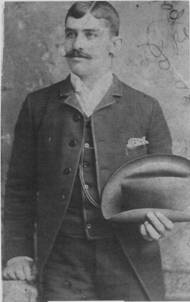
Capt.
Issac Spinsby
Henry
Spinsby
Henry Spinsby
St. Louis
Post Newspaper
April 16, 1909
Spinsby-On Thursday April 15, 1909 at 11 a. m. Henry
Spinsby in his eighty-ninth year.
Funeral from Louis Spellbrink’s funeral parlors.
1923 Franklin Avenue
, on Friday, April 16, at 3:20 p. m. to Crematory.
Incineration private.
[Spinsby info Contributed by relative
Nancy Schroeder]
Stedman James
Capt. W.
Blair
RECALLS MANY
OF THE BOATS
“This company bought from W. A. Blair the excellent
raft boat, the
Silver Crescent
. She was 123 feet long with a 23 foot beam. She was built of selected
Kentucky
oaks and was a fine model. She had the engines of the two-boat Park Painter
of Pittsburgh, with 14 inch cylinders and a 4 1-2 stoke.
She was fitted with a comfortable cabin and was one of the handsomest
and fastest crafts in the entire rafting fleet.”
“The
writer was her master and pilot with Parm Lancaster as mate, James
Stedman as engineer and S. R. Dodds as clerk. For a few weeks Capt. Lon
Bryson was with us, to teach and show us raftsmen how to handle passengers
and freight as well as the clerical work connected with these things”.
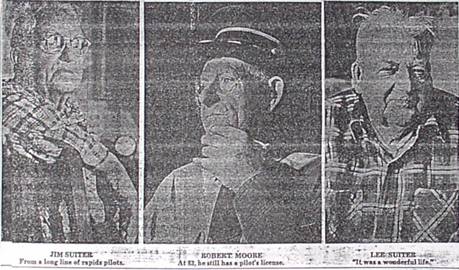
Jim Suiter
Robert Moore
Lee Suiter
Stedman
James (Steadman)
Engineer
The
Times Democrat and Leader
Nov. 19, 1912
Pg. 15
Steadman
James
Wife Jennie Shannon
After an illness of four months, due to paralysis, James Stedman died
at his home in Le Claire Monday night at 9 o’clock.
Mr. Stedman was born in Ohio Jan. 12, 1849, but came to Le Claire
when a young man. He was
married at that place in November, 1873, to Miss Jennie Shannon, who
survives him. Besides his wife,
one son, Fred Stedman, is left to mourn the loss of husband and father.
Henry Stedman, the older son of the deceased, died two years ago.
Funeral services will be held form the Le Claire Presbyterian church
Thursday afternoon.
Photo
by Bob Jones

James
Steadman 1819-1912
Capt.
W. Blair
RECALLS MANY
OF THE BOATS
By
Capt. Walter A. Blair
Career
of Silver Crescent
This
company bought from W. A. Blair the excellent raft boat, the Silver
Crescent. She was 123 feet long with a 23 foot beam. She was built of
selected Kentucky oaks and was a fine model. She had the engines of the
two-boat Park Painter of Pittsburgh, with 14 inch cylinders and a 4 1-2
stoke. She was fitted with a
comfortable cabin and was one of the handsomest and fastest crafts in the
entire rafting fleet.
This boat finished up some rafting and after a few changes and
additions started to revive, on June 17, 1892, the old trade to Burlington.
This was the summer of extremely high water.
The writer was her master and pilot with Parm Lancaster as mate, James
Stedman as engineer and S. R. Dodds as clerk. For a few weeks
Capt. Lon Bryson was with us, to teach and show us raftsmen how to handle
passengers and freight as well as the clerical work connected with these
things.
Our start was not encouraging. The
entire earnings of our first round trip were $16.75.
The increase was slow, but by the end of the season in 1893 we paid a
5 per cent dividend.
Suiters
Last
of The Rivermen At Le Claire
Davenport
Democrat
January 24, 1969
There
is an old saying along the
Mississippi River
that steamboat men live as long as the wake left by the buckets of their
boats. A “bucket” is another
word for a paddle on the wheel, and the wake left by the churning buckets
was always pretty long-which meant steamboat men live a long life.
The
last three steamboat men in Le Claire are living out that old saying.
Robert
A. Moore, who has piloted just about everything from excursion boats to
rafters, will be 83 in May.
Jim Suiter, pilot and master and descendent of a
long line of rapids pilots , is 81.
Lee Suiter, a brother of Jim Suiter and who worked
on “more boats than I can remember,” is 76.
All
have considerable in common besides longevity.
They took to steam boating when they were boys, and haven’t quite
shaken that meandering old river out of their systems.
The boats
upon which they have worked will stir memories among old timers who can hark
back to the river days of tall smoke stacks and deep-throated whistles.
Remember the
St. Paul
and the old J.S. Streckfus excursion boats?
Raft boats like the Eclipse and the J. W. Van Sant or the many
packets on the Diamond Jo Line? The
Suiters and Moore worked these boats at one time or another.
With
affection, they refer to all boats as “she” or “her” and
understandably are saddened by the demise of steam on the river.
Le
Claire was famous as the home of the river men for several years.
“My
dad, John was one of the best pilots in the business,” recalls Jim Suiter
today.
Both
Jim Suiter and Robert Moore were licensed rapids pilots.
“We made good money in those days.
I’d get $25 for taking just a regular steamboat through the rapids.
If a man took a log raft downstream over the rapids,
he might get $100 or $200” says
Moore
.
“Everyone
who didn’t know the rapids was afraid of them.
I learned them from my father, and a pilot pretty well got to know
all the tricks. You’d get near
a ledge of rocks, sight on a tree and hove to the starboard and then you’d
get through. Such stuff as that
was typical.” says Suiter. “I
remember one spot where you’d keep a government light on dead-set aim with
a farmhouse on the
Illinois
side of the river between Clinton and Buffalo.” and a chief engineer’s
license for any navigable
stream. Of alert mind and
memory, the alert 83-year-old
Moore
is full of tales of the
Mississippi
and his eyes sparkle as he talks about them.
“ One
day we were sitting on the fence at recess when I heard a steamboat whistle.
I was only 13 then, and I ran down the hill to look at the boat.
She was the Ten Broeck, and the pilot, Walter Blair, yelled, “boy,
do you want a job? “ Yes-siree, I took that job, and I went from kitchen
flunky to second engineer and chief engineer for the fleet of seven Van Sant
boats.
He quit,
the Van Sants because he didn’t get a raise from $90 to $100 a month and
went to work for Joseph Streckfus at
Rock Island
.
Water Wagon
“I was
chief engineer on the old W.W. an excursion boat running between
St. Louis
and
St. Paul
. Everyone called that boat the
“Water Wagon” because Capt. Streckfus wouldn’t permit any liquor on
board.
Green Tree
In
Le Claire is a large tree called the Green Tree Hotel because rafting crews
often spent the night under its limbs waiting to run the rapids next
morning. It’s limbs were so
sheltering that Walter Blair, the pilot turned-author wrote an entire
chapter in his “Raft Pilot’s Log” on the subject.
“The Green Tree Hotel”
Suiter
left the river as a young man and didn’t return until 1928 when he hired
out as a cub pilot on the Le Claire. A government workboat.
Three years later he qualified for his pilots license, and his boats
helped build a network of wing dams up and down the river “out of willow
bundles and stones.”
He retired
in 1943 after service as master and pilot of the “Ellen” a big
government steamboat with a crew of 22.
Now he lives in Le Claire in a house once owned by another riverman,
the late Henry Horton. An early
engineer.
Last
summer a son-in-law took Jim Suiter out in a small boat.
“I got enough of that little boat in a hurry.
I wanted something big under me,” he smiles.
A Deckhand
Up the road from Jim Suiter lives his brother, Lee who
hired out as a deckhand on the steamer “Eclipse” when he was “about 13
or 14 years old.”
“When
I was a boy there was nothing to do at Le Claire except go on the river,
unless you wanted to work at the quarry or on the farm,” says Lee Suiter.
He
sucked a cigarette and wandered back to the days on the raft boats.
“It was
like being on a picnic. It
wasn’t hard work; it was a wonderful life,”
he reminisces. “ A
deckhand worked for $1 a day and board and it was a darned good board on the
boats.
“I spent
many a year on the river, and it was getting so I could wake up any morning,
look out the boat and tell exactly where I was.”
Lee Suiter
worked his river years as a deckhand and mechanic.
Some times he thinks he made a mistake and should have taken up
farming, or should have gone on and become a pilot: “I knew enough of the
river for the job.” he says a little sadly.
Today,
these three old river men in their twilight years are a rather lonely link
with the exciting river days of yesteryears Le Claire.
Not
by coincidence, each one of them can see the “
Big
River
” from his home. transcribed
by Georgeann McClure
Davenport
Democrat
Feb 3, 1904
Pg. 6
Suiter J. G.
At
his home in Le Claire at 7 o’clock Tuesday morning occurred the death of
J. G. Suiter in his 79th year of his age.
Pleurisy was the cause of death.
The
deceased was born in Sangamon
county
Ill.
Nov. 11, 1825 and came to Le Claire in 1836.
For a long time the deceased operated the raft boat Rambo in
partnership with C. P. Disney, and became widely known as a riverman.
The
deceased was three times married. His
first wife was Mrs. Isabelle Greene of
south Bend
,
Ind.
And the second wife was the mother of his surviving children, Frank Suiter
and Mrs. Bart Stone of Le Claire. The
third wife died several years ago.
Three
brothers also survive, Frank Suiter of De Witt, and Joseph Suiter of Le
Claire. The third brother Wm. M
Suiter died last week.
The
funeral will be held Thursday afternoon at 2’oclock from the Baptist
church at Le Claire.
gmc
WILLIAM H. S. SUITER FROZEN TO DEATH
SAD DECEASE OF PROMINENT OLD SETTLER
Found Dead on Country Road Near Le Claire Saturday
Night-Came Here Nearly seventy
Years Ago, and was Long a Rapids Pilot.
Davenport
Democrat
Jan 25, 1904 Pg 7
The
cold snap has proved fatal in at least one case in this county , and removes
no less a personage than William M. Suiter late president of the Scott
County Pioneer Settler’s’ association.
Mr. Suiter left his home in Le Claire Saturday night, to deliver a
cow to a party living some distance away,.
His relatives became alarmed when he failed to return some hours
afterward, and instituted a search for him.
This resulted in his being found in the roadway, where he had fallen
after being prostrated by the extreme cold.
His hands, feet and face were badly frozen when he was found and he
had been dead for some time. As
he was 77 years of age, the cold had been too severe for his enfeebled
vitality.
Mr.
Suiter had been a resident of Scott county since 1836, his father having
come here the previous year and sent back for his family.
William M. was then 10 years of age, and had been born on the
American bottoms, in
Illinois
, his parents being Phillip and Hannah Pancake Suiter. William H. was a
rapids pilot at the age of 21 and followed that lucrative occupation all his
life, amassing considerable property, in the town of
Le Claire
and its neighborhood. The late
Mrs. J. H. Manwaring of this city was a daughter of his.
Davenport
Democrat
Feb 3, 1904
Pg. 6
Suiter J. G.
At
his home in Le Claire at 7 o’clock Tuesday morning occurred the death of J.
G. Suiter in his 79th year of his age.
Pleurisy was the cause of death.
The
deceased was born in Sangamon
county
Ill.
Nov. 11, 1825 and came to Le Claire in 1836.
For a long time the deceased operated the raft boat Rambo in
partnership with C. P. Disney, and became widely known as a riverman.
The
deceased was three times married. His
first wife was Mrs. Isabelle Greene of
south Bend
,
Ind.
And the second wife was the mother of his surviving children, Frank Suiter
and Mrs. Bart Stone of Le Claire. The
third wife died several years ago.
Three
brothers also survive, Frank Suiter of De Witt, and Joseph Suiter of Le
Claire. The third brother Wm. M
Suiter died last week.
The
funeral will be held Thursday afternoon at 2’oclock from the Baptist
church at Le Claire.
Sweeney
James
The
Davenport Democrat & Leader
Oct. 2, 1927
Pg. 21
James
Sweeney of Le Claire, veteran River Man, Dies
James Sweeney of Le Claire, Ia., a government employee on river boats
for the past 30 years, died this morning at 9 o’clock at St. Luke’s
hospital, Davenport, after a short illness.
He was born in Le Claire on Jan 20, 1869, and had lived all his life
in that place. He was married
on Nov. 25, 1903 to Miss Bertha Lambach at Le Claire.
Mr. Sweeney was a member of snow Lodge, A. F. & a. M. of Le
Claire, and was chancellor commander of the Knights of Pythias lodge of Le
Claire at the time of his death. He
also held membership in the Modern Woodmen of America.
He is survived by his wife and three sisters, Mrs. K. Hugener of
Camnache, Mrs. Mary Reynolds of East Moline and Mrs. Fannie Buckheit of Le
Claire.
The body was taken to the Hill & Fredericks mortuary and will be
removed tonight to his home in Le Claire from where the funeral will be held
Friday at 2:00 p. m. Burial will be in the Glendale cemetery.
“May
the waters that took you away, return you to me”
Leclaire
Rivermen Continued
Previous
Page of LeClaire Rivermen
|


 Captain Rambo; LeClaire,
Iowa
Captain Rambo; LeClaire,
Iowa













